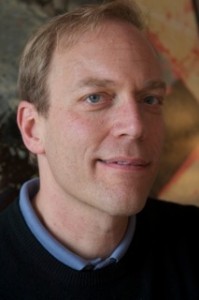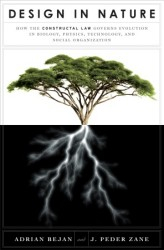Zane ’84 Co-Writes Book About Physics Law Governing Design, Evolution

Peder Zane ’84 has co-written a new book Design in Nature (Doubleday) with Professor Adrian Bejan of Duke University, which describes Bejan’s groundbreaking discovery, the constructal law, a principle of physics that governs all design and evolution in nature.
The constructal law holds that all shape and structure emerges to facilitate flow. Rain drops, for example, coalesce and move together, generating rivulets, streams, and the mighty river basins of the world because this design allows them to move more easily. The question to ask is: Why does design arise at all? Why can’t the water just seep through the ground? The answer is that it flows better with design. This is the same reason we find a similar tree-like structure in the lightning bolts that flash across the sky and in the tree-like structure of our circulatory and nervous systems.
Before the constructal law, scientists knew that these similar tree-like structures arose in nature, but they did not know why. The constructal law identifies the fundamental tendency of nature to generate design to facilitate flow. It tells us the why of what we see before our eyes. The constructal law is a unifying principle because it governs inorganic phenomenon (river basins, lightning bolts) as well as the organic (biological creatures) and the man-made world of technology and ideas (we are governed by the law because we, too, are part of nature).

In addition, the constructal law predicts that these designs should evolve with a particular direction in time—they configure and reconfigure themselves to enhance flow. That is, they get better. Thus, evolution is not a biological phenomenon (just applying to animals) but a law of physics (it applies to everything). Thus, the constructal law provides a new understanding for what it means to be alive. Anything that flows evolves, morphing to persist in time. When the flow stops, it is dead. This is as true for old river beds as it is for human beings.
Bejan’s discovery also provides, for the first time, a physics basis for the idea of purpose and progress in nature. The purpose is to flow more and more easily. The progress is measurable, the evolution of designs that move more mass per unit of useful energy consumed.
Zane says, “I met Adrian in 2007 after receiving a press release from Duke saying that one of its professors had discovered a law of the universe. I thought, ‘that doesn’t happen every day’ and visited him. My profile ran in the News & Observer of Raleigh. About six months later, I asked Adrian—who has published 25 scholarly books and 458 peer-reviewed papers—if he was interested in writing a book for a general audience. He was, and for the next two years we met every week to write this book.”
Zane is an assistant professor of journalism and mass communications at St. Augustine’s College.

